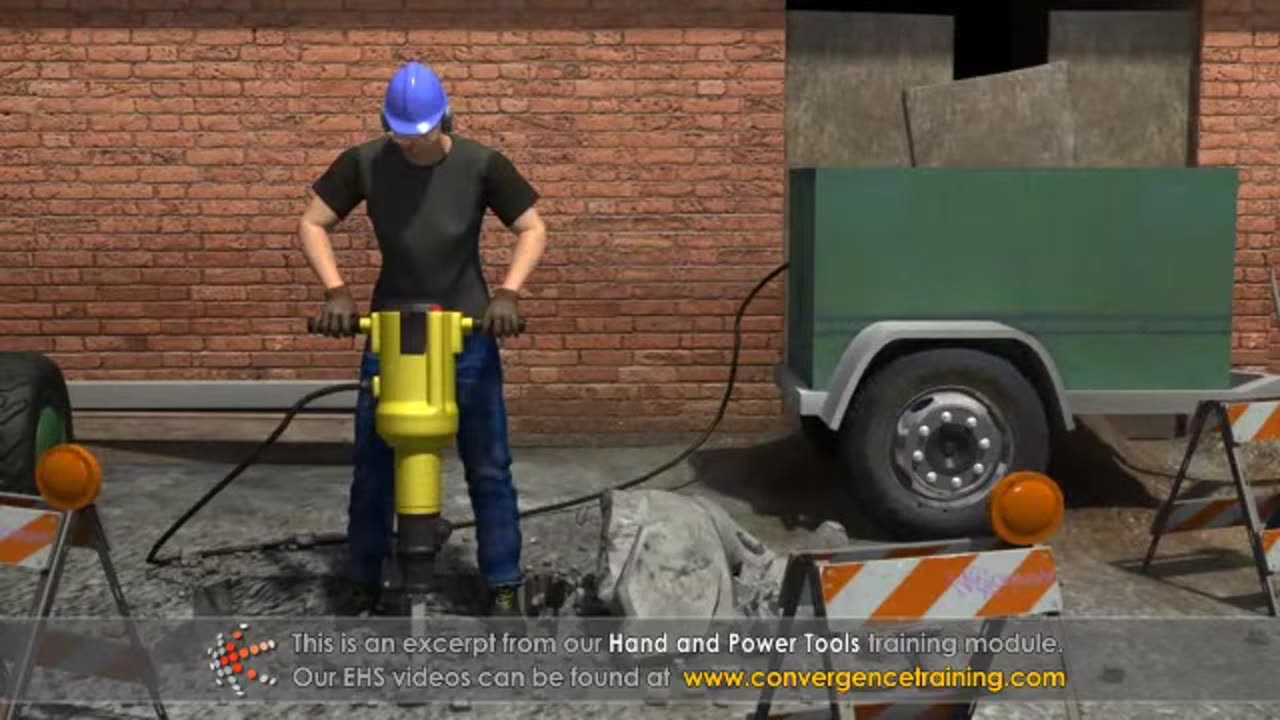Premium Only Content

Hand and Power Tools Training
**Hand and Power Tools Training** is essential for ensuring that employees can safely operate tools in the workplace, preventing accidents, injuries, and damage to equipment or materials. This training covers the correct usage, maintenance, and safety precautions necessary for both hand tools (such as hammers, screwdrivers, and wrenches) and power tools (such as drills, saws, and grinders). Proper training ensures that workers understand the risks associated with these tools and can handle them safely and efficiently.
### Key Elements of Hand and Power Tools Training
#### 1. **Introduction to Hand and Power Tools Safety**
- **Why Training is Important:** Emphasizing the importance of safety in tool usage to prevent injuries, such as cuts, burns, electrical shocks, and musculoskeletal disorders.
- **Regulatory Standards:** Understanding OSHA and ANSI (American National Standards Institute) regulations related to hand and power tool safety.
- **General Tool Safety Guidelines:** Familiarity with best practices to minimize risks, such as using the right tool for the job and maintaining proper posture.
#### 2. **Types of Hand Tools and Their Safe Use**
- **Common Hand Tools:**
- **Hammers:** Different types (claw, sledge, mallets) and their appropriate uses.
- **Screwdrivers:** Understanding flathead, Phillips, and other types, as well as choosing the right size and type for screws.
- **Wrenches:** Different wrenches (open-end, box-end, adjustable) and proper torque application to avoid damaging fasteners.
- **Pliers and Cutters:** Using needle nose, diagonal cutters, and locking pliers correctly for gripping and cutting tasks.
- **Utility Knives and Saws:** Safe handling of cutting tools to avoid accidental injury.
- **Hand Tool Safety:**
- **Inspection:** Checking tools for defects such as broken handles, worn edges, or loose parts before use.
- **Proper Handling:** Using hand tools with proper ergonomics to avoid hand strain, and ensuring the tool is used only for its intended purpose.
- **Tool Storage:** Keeping tools in good condition by storing them in designated places to prevent damage or misuse.
#### 3. **Types of Power Tools and Their Safe Use**
- **Common Power Tools:**
- **Drills:** Understanding types (corded vs. cordless), speeds, and bits, and using drills safely.
- **Saws (Circular, Jigsaws, and Table Saws):** Correct setup, use, and handling to avoid kickback or blade binding.
- **Grinders and Sanders:** Proper use of rotating tools to ensure control and prevent accidents.
- **Rotary Tools (e.g., Dremels):** Safe handling and application for cutting, sanding, or grinding small areas.
- **Impact Tools (e.g., nail guns, impact wrenches):** Preventing accidental firing and ensuring proper safety precautions are followed.
- **Electric and Pneumatic Tools:** Understanding the differences between electric, battery-powered, and pneumatic tools, and following safety protocols for each.
- **Power Tool Safety:**
- **Tool Inspections:** Checking for issues like frayed cords, worn brushes, or malfunctioning parts before use.
- **Correct Settings:** Setting the appropriate speed or power setting for specific tasks to ensure efficiency and safety.
- **Proper Handling:** Keeping both hands on the tool when operating it (if required), maintaining a stable grip, and ensuring that the tool is properly grounded (in case of electric tools).
- **Personal Protective Equipment (PPE):** Using eye protection, gloves, hearing protection, and other necessary PPE depending on the tool being used.
#### 4. **Tool-Specific Hazards and Preventing Injuries**
- **Cutting Tools (Saws, Knives, etc.):** Preventing cuts by keeping hands clear of blades, using the correct blade for materials, and maintaining a stable cutting surface.
- **Grinding and Polishing Tools:** Managing flying debris and sparks by wearing protective eye and face shields, and ensuring that the tool is properly grounded.
- **Drills and Rotating Tools:** Preventing entanglement or kickback by maintaining a firm grip and ensuring that the material being worked on is securely held.
- **Compressed Air Tools (Pneumatic Tools):** Understanding the risks of flying debris, compressed air pressure, and ensuring hoses are in good condition.
- **Electrical Tools:** Avoiding electrical shock by using tools with proper insulation, avoiding using tools with exposed wiring, and ensuring the tool is properly grounded.
#### 5. **Personal Protective Equipment (PPE)**
- **Appropriate PPE for Hand Tools:**
- **Gloves:** To protect hands from abrasions or cuts.
- **Eye Protection:** Safety goggles or face shields to protect against flying debris, dust, or splinters.
- **Hearing Protection:** When using power tools that create loud noises (e.g., drills, saws, grinders).
- **Aprons and Sleeves:** To protect against hot tools, sparks, or sharp edges.
- **Appropriate PPE for Power Tools:**
- **Respirators:** For sanding, grinding, or cutting operations that generate dust or fumes.
- **Face Shields:** To protect against flying debris and sparks.
- **Anti-vibration Gloves:** To reduce hand-arm vibration risks when using power tools like grinders or drills.
#### 6. **Maintenance and Care of Tools**
- **Routine Inspections:** Checking for wear, tear, or damage on both hand and power tools before and after each use.
- **Sharpening and Cleaning:** Regular maintenance of cutting tools to ensure proper functionality and safety. This includes cleaning dust and debris from power tools and ensuring blades remain sharp.
- **Lubrication:** For tools with moving parts (e.g., drills, saws, grinders), ensuring they are properly lubricated to reduce wear and tear.
- **Battery Maintenance:** For cordless tools, checking and maintaining battery life and ensuring the battery is securely connected.
#### 7. **Safe Work Practices and Procedures**
- **Tool-Specific Procedures:** Following the manufacturer’s guidelines for each tool, including setup, operation, and shutdown procedures.
- **Working with Others:** Maintaining a safe distance from coworkers while operating power tools and ensuring that the work area is clear of obstructions.
- **Tool Handling:** Ensuring proper grip and control while using tools to reduce the risk of losing control or accidentally injuring oneself or others.
- **Reporting Defective Tools:** Workers should immediately report any defective tools to supervisors, ensuring they are repaired or replaced before use.
#### 8. **Common Injuries and How to Avoid Them**
- **Cuts and Lacerations:** Preventing hand and finger injuries by using tools with proper safety features, and by keeping hands away from blades.
- **Eye Injuries:** Wearing safety goggles or face shields to protect eyes from flying debris or sparks.
- **Electric Shock:** Using insulated tools, avoiding wet work areas, and ensuring tools are properly grounded to prevent shock.
- **Hearing Damage:** Wearing ear protection when operating loud power tools to avoid long-term hearing loss.
- **Sprains and Strains:** Using ergonomic techniques and avoiding repetitive motions that could lead to musculoskeletal injuries.
#### 9. **Tool Storage and Organization**
- **Storing Hand Tools:** Keeping tools in toolboxes or tool racks to avoid damage and ensure quick access when needed.
- **Storing Power Tools:** Properly storing power tools in a dry, safe area to avoid damage, especially when they have electrical components.
- **Tool Maintenance Stations:** Having dedicated areas for cleaning, maintaining, and storing tools to keep them in good condition.
### Benefits of Hand and Power Tools Training:
- **Reduced Accidents and Injuries:** Proper training and safe practices minimize the risk of injuries such as cuts, electric shocks, and eye injuries.
- **Increased Productivity:** Workers can use tools more efficiently, which reduces downtime and ensures tasks are completed faster and with higher precision.
- **Tool Longevity:** Proper maintenance and care increase the lifespan of tools, reducing the need for costly repairs or replacements.
- **Regulatory Compliance:** Ensuring that employees are trained to follow safety standards and guidelines helps the company remain compliant with OSHA and other safety regulations.
### Training Methods:
- **Classroom Training:** Teaching theoretical knowledge of hand and power tools, safety guidelines, and regulatory standards.
- **Hands-on Training:** Providing practical, on-the-job training where workers operate tools under supervision to ensure they understand safe handling and operation.
- **Online Training:** Offering e-learning modules for basic knowledge, with practical demonstrations to follow.
- **Refresher Courses:** Regularly updating training to reinforce safe work practices and introduce new tools or safety regulations.
Would you like assistance in designing a specific **Hand and Power Tools Training** program for your team or workplace?
-
 58:14
58:14
theDaily302
19 hours agoThe Daily 302- Tim Ballard
60.8K10 -
 13:22
13:22
Stephen Gardner
13 hours ago🔥You'll NEVER Believe what Trump wants NOW!!
109K300 -
 54:56
54:56
Digital Social Hour
1 day ago $11.17 earnedDOGE, Deep State, Drones & Charlie Kirk | Donald Trump Jr.
61.5K5 -
 DVR
DVR
The Trish Regan Show
15 hours agoTrump‘s FCC Targets Disney CEO Bob Iger Over ABC News Alleged Misconduct
66.1K39 -
 1:48:19
1:48:19
The Quartering
15 hours agoElon Calls White People Dumb, Vivek Calls American's Lazy & Why Modern Christmas Movies Suck!
147K112 -
 2:08:42
2:08:42
The Dilley Show
16 hours ago $37.19 earnedH1B Visa Debate, Culture and More! w/Author Brenden Dilley 12/26/2024
126K42 -
 4:55:59
4:55:59
LumpyPotatoX2
19 hours agoThirsty Thursday on BOX Day - #RumbleGaming
115K8 -
 1:04:52
1:04:52
Geeks + Gamers
17 hours agoDisney RATIO'D on Christmas Day | Mufasa Embarrassed By Sonic 3
84.3K11 -
 8:27:46
8:27:46
Sm0k3m
21 hours agoRumblers Assemble
53.5K3 -
 10:37
10:37
Russell Brand
2 days agoHow is this even allowed?
210K977